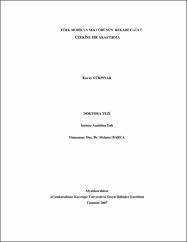Türk Mobilya Sektörünün Rekabet Gücü Üzerine Bir Araştırma
Citation
Gürpınar Koray ‘’Türk Mobilya Sektörünün Rekabet Gücü Üzerine Bir Araştırma’’ ‘’A Research Over The Competıtıon Power Of The Turkısh Furnıture Sector’’ Afyon Kocatepe Üniversitesi Afyonkarahisar 2007Abstract
Bu çalışmanın amacı Türk mobilya sektörünün uluslararası pazarlardaki rekabet gücünü araştırmaktır. Türk mobilya sektöründeki rekabet olgusu, kaynakları ve sektörün performansının sürekliliği, sektörün ulusal ekonomideki önemi, oluşturduğu istihdam ve ihracattaki payı nedeni ile araştırmaya değer olarak görülmüştür. Sektör üç aşamalı olarak araştırmaya konu edilmiştir:
Birinci aşamada, ulusal ve uluslararası ihracat ve ithalat verileri kullanılarak çeşitli indeksler ile sektörün uluslararası pazarlardaki rekabet gücü belirlenmeye çalışılmıştır. İkinci aşamada belirlenen rekabet gücünün dayanakları Porter’ın geliştirdiği elmas modeli ile analiz edilmeye çalışılmıştır. Üçüncü aşamada ise, anket yöntemi ile sektörde yönetici konumunda olan insanlardan sektörün avantaj kaynakları, sorunları ve geleceğine ilişkin görüşleri alınarak rekabet gücü değerlendirilmiştir.
Uluslararası pazarlardaki performansa bağlı olarak 2001-2004 döneminde Türk mobilya sektörü için hesaplanan endeks değerleri 1’in altında ve 2005-2006 dönemi içinde 1’in üzerindedir. 1’in altındaki endeks değerleri göstermektedir ki 2001-2004 arasında Türk mobilya sektörü uluslararası rekabette dezavantaja sahiptir. Endeks değerlerinin 2005-2006 dönemi için 1’in üzerinde olması göstermektedir ki Türk mobilya sektörü uluslar arası pazarlarda rekabetçi üstünlüğe sahiptir. Bununla birlikte bir trend olarak değerlendirildiğinde, Türk mobilya sektörünün 2001’den bu yana sürekli olarak artan bir rekabet gücü gösterdiği söylenebilir.
Bu başarının arkasındaki nedenlere Porter’ın elmas modeli çerçevesinde bakıldığında, ulusal pazarda artan talep ve talebin giderek daha fazla sofistike olması, nitelikli iş gücü ve firmaların dışa açılma stratejileri olduğu söylenebilir. Yöneticiler üzerinde yapılan anket çalışmasında da elmas modeli ile yapılan analizde varılan bulguları destekleyici sonuçlar bulunmuştur.
Yapılan indeks çalışmaları, elmas modeli analizi ve yönetici görüşlerinin değerlendirilmesi sonucunda, Türk mobilya sektörünün artan küresel rekabete rağmen rekabetçi konumunun zaman içerisinde güçlendiği gözlemlenmiştir. Ancak sektörün rekabet gücünü geliştirmek ve kalıcı kılabilmek için bundan sonra üretim odaklı ve maliyet kontrolü yerine Ar-Ge, tasarım ve pazarlama gibi daha ileri rekabet unsurları üzerine yoğunlaşmak gerekmektedir. This dissertation aims at exploring the international competition power of Turkish furniture industry. The concept of competition among Turkish furniture industry, resources and sustainability of the performance are thought to worth to be researched because of the importance of the industry among the national economy, the level of employment created by the industry and the share of the industry among exports. The sector has been searched in three stages.
In the first stage, the competition power of the sector has been tried to be determined using the various indices about national and international export and import data. In the second stage, the sources of the competition power which is determined in the first stage has been tried to be analyzed with the Porter’s Dimond Model. In the last stage, the competition power has been evaluated with a survey result which collects the people’s opinions who have management positions among the sector about advantages, problems of the sector, and their expectations for the future of the sector.
The calculated index values of Turkish furniture sector for the period 2001-2004 are succesively under 1 and over 1 for the period 2005-2006, depending on the performance in the international markets. The index values under 1 show that Turkish furniture sector has disadvantage in the international competition between 2001-2004. The index values being over 1 for the period 2005-2006 shows that Turkish furniture sector has got the competitive advantage in the international markets.
However it can be said that the Turkish furniture sector has increasingly showed competitive advantage since 2001, as it is evaluated as a trend. It can be said that increasing demand in the national market and getting more sophisticated demand, qualified labor force and the foreign market oriented strategies of the firms are the reasons behind this succes in the perspective of the Porter’s Diamond Model. The supporting results have been found in the survey conducted with the managers as the results reached in the analysis of the Porter’s Dimond Model.
It has been concluded that Turkish furniture sector has been strengthened its competitive position in the global competitive markets in which competition is gradualy increasing through the evaluation of conducted index study, Porter’s Diamond Model analyze and the survey about managers’ opinions. But, it is necessary to concenrate on the advanced competitive factors such as R&D, design, and marketing instead of production focused and cost controlled production to improve the competitive power of the sector and sustain it.



















